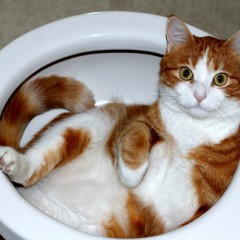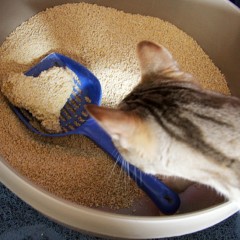Cats are clean animals by nature, so this is good news if you are thinking about getting a cat as a companion. A cat will not only bathe themselves, but they seem to have a natural ability and understanding of how the litter box works. However, there are times (and cats) that just don’t seem to get the whole concept of using an indoor bathroom facility. For those of you who have one of these cats or are just concerned about getting a cat and potty training it, here are some tips to help you along the way.
Kitten Training
 Kittens begin to cover their waste at about 4 weeks of age – this is a natural instinct and not necessarily taught by the mother cat. Kittens are the easiest to train as they don’t usually come with any bad habits that you have to break, unless they are barn cats. This situation may require you to be extra diligent in the training process which we will cover later.
Kittens begin to cover their waste at about 4 weeks of age – this is a natural instinct and not necessarily taught by the mother cat. Kittens are the easiest to train as they don’t usually come with any bad habits that you have to break, unless they are barn cats. This situation may require you to be extra diligent in the training process which we will cover later.
When you first bring a kitten into your home one of the first things you should do is show it where the litter box is. What I found helpful was to put the kitten in the litter and let them find their way out of it. I do this a few times to make sure the kitten is very familiar with the location. You can also scratch their paws through it a few times, so they get the idea.
Kittens that were born in the outdoors, such as a feral community or a barn, may have problems associating going to the bathroom with a litterbox. For this type of situation it is best to keep the kitten confined to one room of your home (like a spare bedroom or bathroom). Place a clean litterbox in the room with them and show them how it works by scratching their paws in it. In addition, if you leave a bit of urine or feces behind, your kitten will know this is the place to do her business; however, not too much or it may turn your cat off the whole process. With a little patience and perseverance, your kitten will pick up the idea.
Litter Box 101
 For the most part, cats prefer a litter box that is around 6 inches deep. A good rule of thumb is the box should be big enough for the cat to see what’s in there, step in, turn around and cover. The tray can also be covered or open and are readily available at most retail outlets or pet stores.
For the most part, cats prefer a litter box that is around 6 inches deep. A good rule of thumb is the box should be big enough for the cat to see what’s in there, step in, turn around and cover. The tray can also be covered or open and are readily available at most retail outlets or pet stores.
After you have purchased a litter box be sure to put it in a place that is convenient for your cat and is in a low traffic area of your home. Cats like privacy so providing it with a quiet spot will help encourage the training process.
If you have more than one cat, you may need to add an additional litter tray. Some cats even like to use one box for urine and the other for feces. Be sure to keep the boxes clean, as again, some cats can become very fussy about their washroom and won’t use it if it is too dirty – think of using a gas station bathroom and you will know where your cat is coming from..
Cat Litter is Not All Created Equally
There are many types of cat litter on the market today. It comes in grainy, sandy, all-natural corn, crystals and clay. Each of these have their benefits and will depend on your budget and what your cat prefers. Personally, I have tried them all and I keep coming back to the clumping. This litter has a bit of glue in it that sticks to feces and forms the urine into easy-to-pick-up balls. In addition, this litter mocks sand that cats will often seek outside when needing to go.
Clumping litter comes in many strengths and can be fine or grainy, depending on the company that makes it. It’s easy to cover up for them and easy to dispose of for you. However, watch out for the heavily perfumed litters as some cats can be put off my strong scents.
Clay litter is cheap to buy; however, you have to throw the entire contents of the box out once it becomes laden with urine. It tends to smell after only a few uses and is a bit of a pain to constantly clean and replace.
For those of you that may have cats that are allergic to some of the other types of litters, there is the all-natural corn litter. This works well, has no odor to the litter and is dust-free. However, I find the pee-balls break apart quite easily so its harder to get the box thoroughly cleaned and may pose a problem is you have more than one cat or aren’t as diligent in cleaning the box. It is also quite pricey in comparison to other litters.
Litter that comes in a crystal format is very pricey and I would only recommend it for a one cat home. It does soak up the urine, but like clay, you have to throw the entire contents out and replace with fresh. The advantages is that this type of cat litter has absolutely no dust to it, so its great for allergies in you or your cat.
Litter training your cat or kitten doesn’t have to be a hassle. Be patient and get to know your cats preferences and habits. Before you know it, you will have a well-trained feline companion that will bring you years of joy and pleasure.
